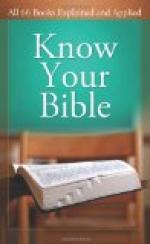* * * * *
Chapter 2.
Exodus.
Name. The name Exodus means a going out or departure.
Subject The subject and key-word of the book is redemption (3:7, 8; 12:13 etc.), particularly that half of redemption indicated by deliverance from an evil plight. It records the redemption of the chosen people out of Egyptian bondage, which becomes a type of all redemption in that it was accomplished (1) wholly through the power of God, (2) by a means of a deliverer (3) under the cover of blood.
Purpose. At this point Old Testament history changes from that of the family, given in individual biographies and family records, to that of the nation, chosen for the divine purposes. The divine will is no longer revealed to a few leaders but to the whole people. It begins with the cruel bondage of Israel in Egypt, traces the remarkable events of their delivery and ends with a complete establishment of the dispensation of the Law. The aim seems to be to give an account of the first stage in the fulfillment of the promises made by God to the Patriarchs with reference to the place and growth of the Israelites.
Contents. Two distinct sections are usually given by students: the historical, included in chapters 1-19 and the legislative, comprising chapters 20-40. The first section records: the need of deliverance; the birth, training and call of the deliverer; the contest with Pharaoh; the deliverance and march through the wilderness to Sinai. The second gives the consecration of the nation and the covenant upon which it was to become a nation. The laws were such as to cover all the needs of a primitive people, both moral, ceremonial and civic with directions for the establishment of the Priesthood and Sanctuary.
Exodus and Science, Scientific research has gone far toward establishing the truthfulness of the Exodus record, but has brought to light nothing that in any way discounts it. It has shown who the Pharaoh of the oppression and Exodus was (Rameses. II, the Pharaoh of the oppression and Merenpth II, the Pharaoh of the Exodus.) and has discovered Succoth. It has shown that writing was used long before the Exodus and has discovered documents written before that period. It has thus confirmed the condition of things narrated in the Bible.
Analysis.
I. Israel in Egypt, 1:1-12:36.
1. The bondage, Ch. 1.
2. The deliverer, Chs. 2-4.
3. The contest with Pharaoh, 5:1-12:38.
II. Israel Journeying to Sinai, 12:37-18: end.
1. The exodus and passover, 12:37-13:16.
2. Journeying through Succoth to the Red Sea, 13:17-15:21.
3. From the Red Sea to Sinai, 15:22-18 end.
III. Israel at Sinai, Chs, 10-40.
1. The people prepared, Ch. 19.
2. The moral law, Ch. 20.
3. The civil law, 21:1-23:18.
4. Covenant between Jehovah and Israel, 23:20-24 end.




